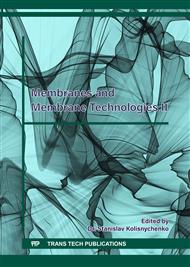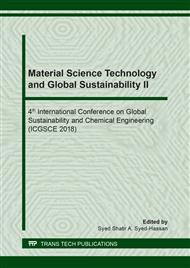[1]
M.A. Barakat, New trends in removing heavy metals from industrial wastewater, Arabian Journal of Chemistry. 4 (2011) 361-377.
DOI: 10.1016/j.arabjc.2010.07.019
Google Scholar
[2]
R. Singh, Hybrid membrane systems—applications and case studies. Hybrid Membrane Systems for Water Purification, Elsevier Science, Amsterdam, (2005).
DOI: 10.1016/b978-185617442-8/50004-x
Google Scholar
[3]
A.K. Shrivastava, A review on copper pollution and its removal from water bodies by pollution control technologies, Indian Journal of Environmental Protection. 29 (2009) 552-560.
Google Scholar
[4]
Environmental Requirements Department of Environment, Ministry of Natural Resources and Environment (2010).
Google Scholar
[5]
F. Fu, Q. Wang, Removal of heavy metal ions from wastewaters: A review, Journal of Environmental Management. 92 (2011) 407-418.
DOI: 10.1016/j.jenvman.2010.11.011
Google Scholar
[6]
Y. Huang, J. R. Du, Y. Zhang, D. Lawless, X. Feng, Removal of mercury (II) from wastewater by polyvinylamine-enhanced ultrafiltration, Sep. Purif. Technol. 154 (2015) 1–10.
DOI: 10.1016/j.seppur.2015.09.003
Google Scholar
[7]
C.Y. Wu, H. Mouri, S.S. Chen, D. Z. Zhang, M. Koga, J. Kobayashi, Removal of trace-amount mercury from wastewater by forward osmosis, Journal of Water Process Engineering, 14 (2016) 108-116.
DOI: 10.1016/j.jwpe.2016.10.010
Google Scholar
[8]
H. Ramadan, A. Ghanem, A., H. El-Rassy, Mercury removal from aqueous solutions using silica, polyacrylamide and hybrid silica-polyacrylamide aerogels, Chem. Eng. J. 159 (2010) 107-115.
DOI: 10.1016/j.cej.2010.02.051
Google Scholar
[9]
M. Arbabi, N. Golshani, Removal of copper ions Cu (II) from industrial wastewater, International Journal of Epidemiologic Research. 3 (2016) 283-293.
Google Scholar
[10]
A.L. Ahmad, S.Y. Olatunji, Z. A. Jawad, Thickness Effect on the Morphology and Permeability of CO2/N2 Gases in Asymmetric Polyetherimide Membrane, J. Phys. Sci. 28 (2017) 201–213.
DOI: 10.21315/jps2017.28.s1.13
Google Scholar
[11]
ASTM D888 ASTM D888. Standard Test Method for Dissolved Oxygen in Water.
Google Scholar
[12]
ASTM D1252-9. standard test methods for chemical oxygen demand (dichromate oxygen demand) of water.
DOI: 10.1520/d1252-06r20
Google Scholar
[13]
ASTM D5907-13. Standard Test Methods for Filterable Matter (Total Dissolved Solids) and Nonfilterable Matter (Total Suspended Solids) in Water.
DOI: 10.1520/d5907-96a
Google Scholar
[14]
N.A. Sulaiman, N. Z. K. Shaari, N.A. Rahman, Removal of Cu (II) and Fe (II) Ions Through Thin Film Composite (TFC) With Hybrid Membrane, J. Eng. Sci. Tech. (2016) 36-49.
Google Scholar
[15]
M.A. Zulfikar, A. W. Mohammad, A. A. Kadhum, N. Hilal, Synthesis and characterization of poly(methyl methacrylate)/SiO2 hybrid membrane, Mater. Sci. Eng., A. 452-453 (2007) 422-426.
DOI: 10.1016/j.msea.2006.10.147
Google Scholar
[16]
F. Shi, Y. Ma, J. Ma, P. Wang, W. Sun, Preparation and characterization of PVDF / TiO2 hybrid membranes with different dosage of nano-TiO2, J. Memb. Sci. 389 (2012) 522–531.
DOI: 10.1016/j.memsci.2011.11.022
Google Scholar
[17]
C. K. Yeom, K. H. Lee, A study on desorption resistance in pervaporation of single component through dense membranes, J. Appl. Polym. Sci. 63 (1997) 221–232.
DOI: 10.1002/(sici)1097-4628(19970110)63:2<221::aid-app9>3.0.co;2-x
Google Scholar
[18]
C. Ding, J. Yin, B. Deng, Effects of Polysulfone (PSf) Support Layer on the Performance of Thin-Film Composite (TFC) Membranes, J Chem Proc Eng. 1 (2014) 1-8.
DOI: 10.17303/jce.2014.102
Google Scholar
[19]
Z. Xie, Hybrid Organic-Inorganic Pervaporation Membranes for Desalination, thesis submitted in fulfilment of the requirements of the degree of Doctor of Philosophy, (2012).
Google Scholar
[20]
A. Raisi, A. Aroujalian, Aroma compound recovery by hydrophobic pervaporation: the effect of membrane thickness and coupling phenomena, Sep. Purif. Technol. 82 (2011) 53–62.
DOI: 10.1016/j.seppur.2011.08.018
Google Scholar



